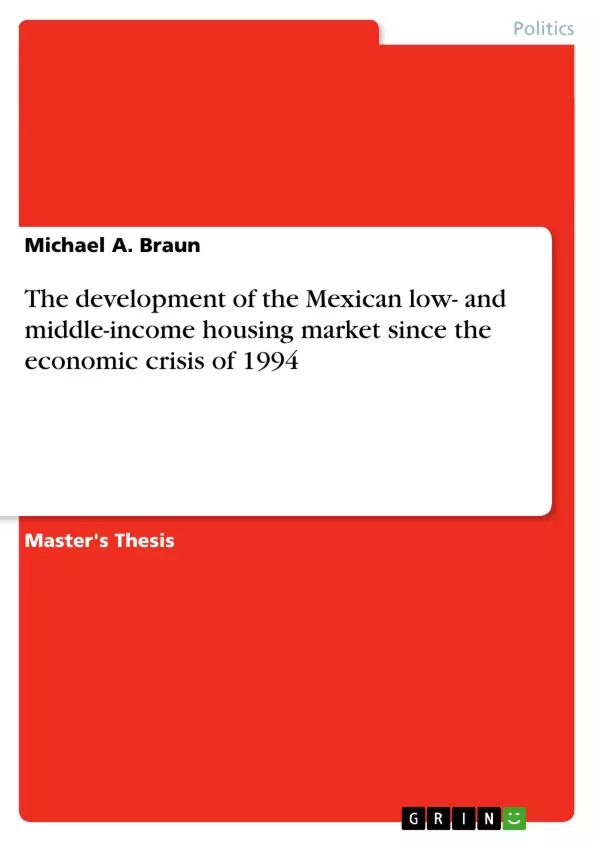A devaluation of the Peso in 1994 threw Mexico into economic turmoil, triggering
the worst recession for over half a century. Since then the nation made an impressive
recovery on many scenes ranging from economics to society. Also the housing
market has improved dramatically for various reasons such as significant policy
changes. Only the general, systematic housing shortage, the under-supply of
mortgages and the under-capitalization of developers still hindered further growth.
This was yet addressed by the Fox government introducing new approaches and
special agencies to keep social stability and enhance further economic growth.
Therefore the thesis points on the rather recent developments of the Mexican
housing market including the question how it became the way it is. Furthermore,
the political and economic motivations and influence of both, public and private
local and foreign actors to the market, without which neither it would not have
grown that much, nor will grow as projected, are highlighted. Moreover, potential
obstacles to further market growth and increased stability such as an ongoing lack
of capital are named, and promoted along with ideas beyond like environmentally
friendlier approaches that are in the long-term favor of the Mexican society.
Inhaltsverzeichnis (Table of Contents)
- Summary introduction
- Rationale
- Research question and aim of the paper
- Theories, state of the art, and academic method
- Mexico, a developing country in a emerging region
- Mexico's economic development since the Tequila crisis
- Increased regional integration and free trade
- Liberalization and foreign direct investments
- Crude oil sales & transfers from foreign Mexicans
- Political and legal improvements were making the way
- Mexico's poverty, demographics, and society changes
- Summary of significant developments since 1994
- The Mexican housing market
- Three-fold weak grounds, but significant growth potential
- General, systemic housing shortage
- Under-supply with mortgages since 1994
- Severe under-capitalization of housing developers
- Customer segmentation in the market
- Affordable entry-level homes for low-incomes
- Residential housing for a growing middle class
- Luxury housing for the top earners
- Change in the customer base
- Changes and growth of Mexico's population
- A changing society demands individual housing
- Mexico's economic success leads to a higher demand
- Poor performance of the housing sector
- Summary on reasons, segments and changes in housing
- Driving forces for the increase of the Mexican housing base
- Governmental motivations
- Main aim: extend and keep social stability
- Catering for a growing middle class
- Support for further economic development
- Motivations of international financial actors
- Mainly politically motivated actors
- Mainly economically motivated actors
- Governmental vehicles of motivation and work
- Federal mortgage society
- Federal pension funds
- Summary on the Mexican housing structure
- Foreign involvement and motivation in Mexican housing
- Politically motivated international actors
- World Bank and International Financial Corporation
- Inter-American Development Bank
- Economically motivated financial actors
- Foreign commercial banks including local subsidiaries
- Mutual funds and private equity
- Interactions and summary on foreign involvement
- Assessment of the situation and potential obstacles
Zielsetzung und Themenschwerpunkte (Objectives and Key Themes)
This thesis aims to analyze the development of the Mexican low- and middle-income housing market since the 1994 economic crisis. It explores the driving forces behind the market's growth, the involvement of both domestic and international actors, and the challenges that remain.
- The impact of the 1994 economic crisis on the Mexican housing market
- The role of government policies in shaping the housing market
- The motivations of international financial actors in investing in Mexican housing
- The challenges and obstacles facing the Mexican housing market
- The potential for future growth in the Mexican housing market
Zusammenfassung der Kapitel (Chapter Summaries)
The first chapter lays out the rationale for the thesis, defines the research question and aim, and outlines the theoretical framework and methods employed. Chapter two provides a detailed overview of Mexico's economic development since the 1994 crisis, highlighting the key factors influencing the housing market. Chapter three dives into the Mexican housing market itself, exploring its challenges, customer segmentation, and the changing dynamics of the market. Chapter four examines the driving forces behind the increase of the Mexican housing base, exploring both governmental motivations and the role of international actors. Chapter five delves into the specific involvement and motivations of foreign actors in Mexican housing, focusing on both politically and economically driven participants. Chapter six provides an assessment of the current situation and highlights potential obstacles for the market's future development.
Schlüsselwörter (Keywords)
The key terms and concepts explored in this thesis include the Mexican housing market, economic crisis, low- and middle-income housing, government policies, international financial actors, foreign direct investment, social stability, economic development, and market challenges.
- Arbeit zitieren
- Michael A. Braun (Autor:in), 2007, The development of the Mexican low- and middle-income housing market since the economic crisis of 1994, München, GRIN Verlag, https://www.grin.com/document/116898



